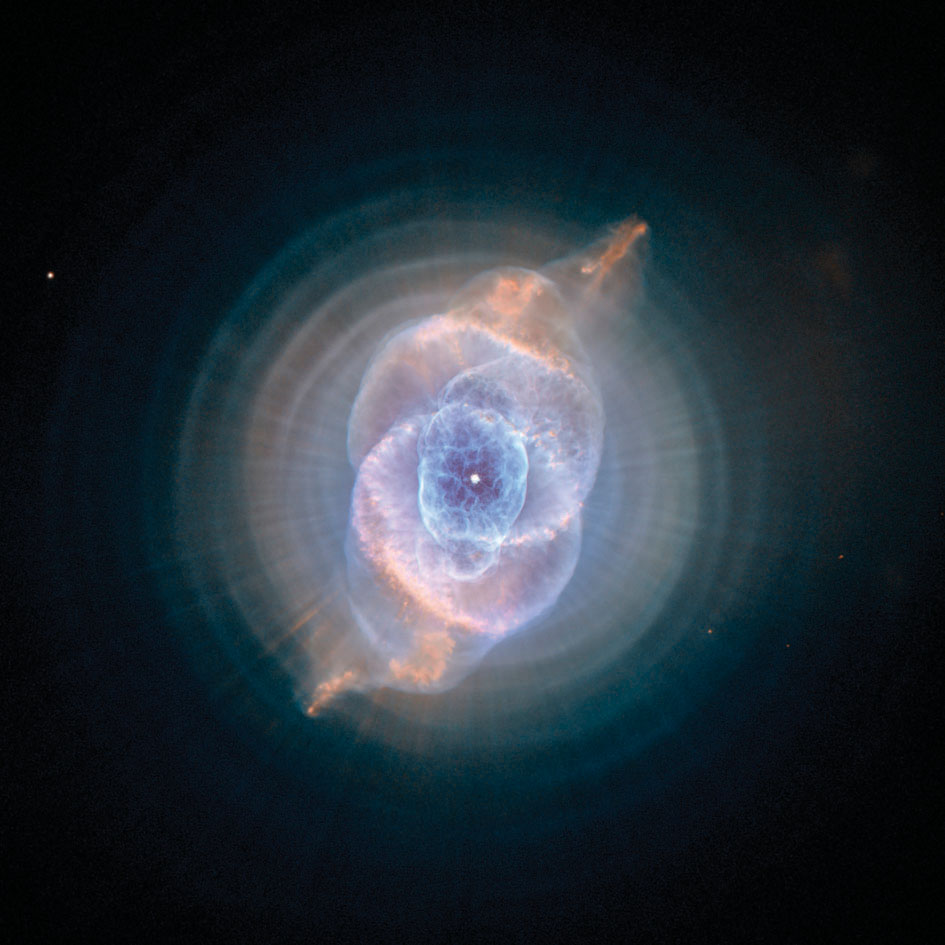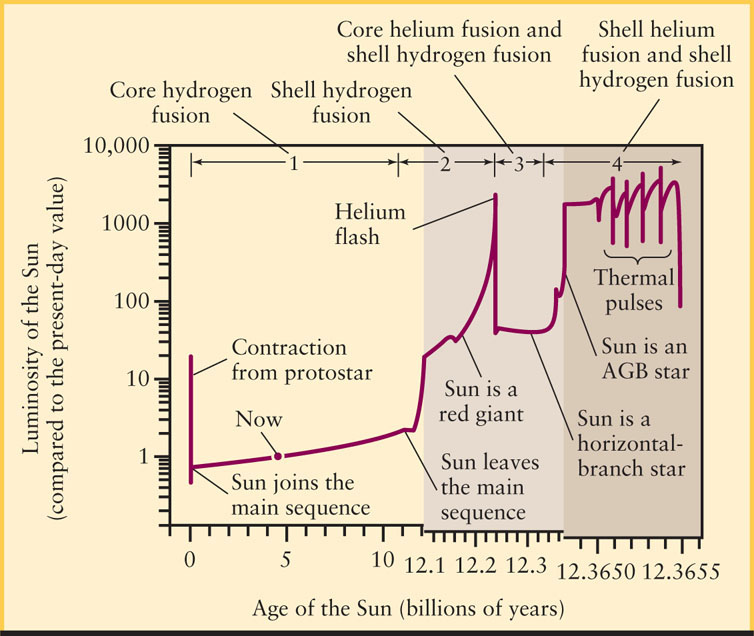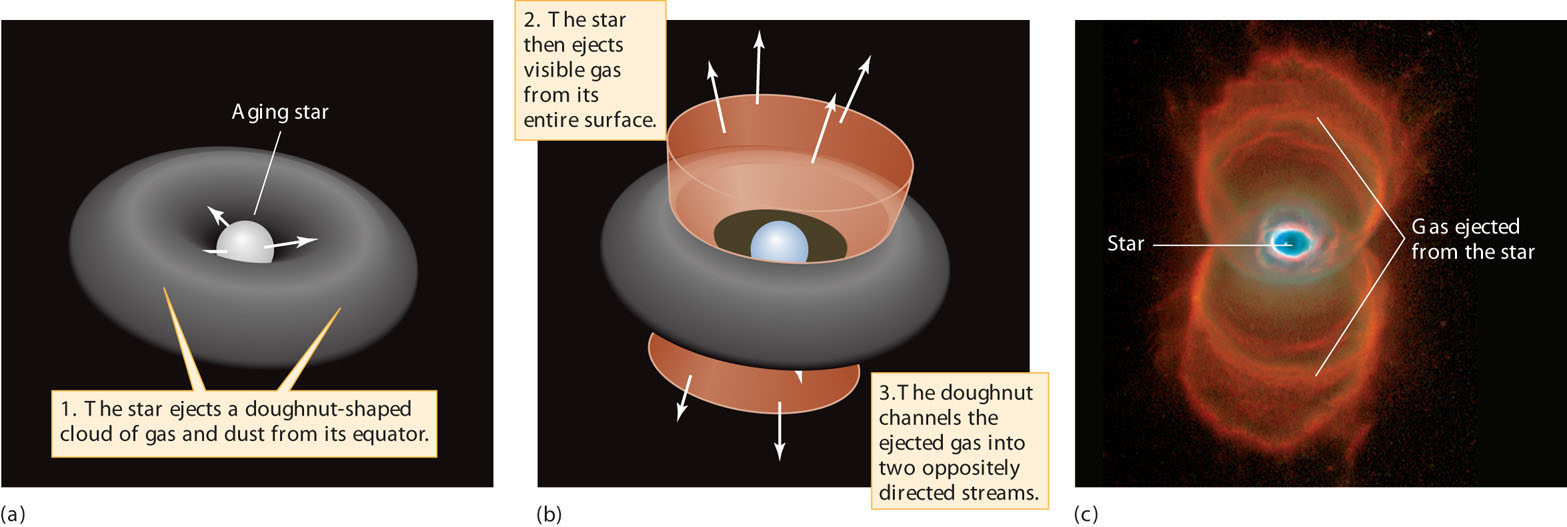20-3 Stars of moderately low mass die by gently ejecting their outer layers, creating planetary nebulae
An aging AGB star casts off much of the mass that it possesses and makes a beautiful glowing nebula
For a star, like our Sun, that began with a moderately low mass (between about 0.4 and 4 M⊙), the AGB stage in its evolution is a dramatic turning point. Before this stage, a star loses mass only gradually through steady stellar winds. But as it evolves during its AGB stage, a star divests itself completely of its outer layers. The aging star undergoes a series of bursts in luminosity, and in each burst it ejects a shell of material into space. (The shell around the AGB star TT Cygni, shown in Figure 20-4, was probably created in this way.) Eventually, all that remains of a low-mass star is a fiercely hot, exposed core, surrounded by glowing shells of ejected gas. This late stage in the life of a star is called a planetary nebula see Figure 20-5. (The left-hand image on the opening page of this chapter also shows a planetary nebula called the Helix Nebula.)

The Cat’s Eye Nebula Named after its shape, this nebula was first discovered in 1786. The exposed core of the central star—clearly visible in the image—is about 10,000 times more luminous than the Sun, and its intense ultraviolet radiation powers the nebula by ionizing its gas. While the nebula is hotter than the Sun, the gas is too diffuse to shine by thermal radiation as the Sun does. Instead, like all planetary nebula, the visible light comes from emission lines: After electrons are excited to higher energies, photons are emitted as the electrons cascade down to lower energies in the gas’s atoms. As with many planetary nebulae, the mechanisms shaping the intricate visible structures are not well understood.
Making a Planetary Nebula
To understand how an AGB star can eject its outer layers in shells, consider the internal structure of such a star as shown in Figure 20-2. As the helium in the helium-fusing shell is used up, the pressure that holds up the dormant hydrogen-fusing shell decreases. Hence, the dormant hydrogen shell contracts and heats up, and hydrogen fusion begins anew. This revitalized hydrogen fusion creates helium, which rains downward onto the temporarily dormant helium-fusing shell. As the helium shell gains mass, it shrinks and heats up. When the temperature of the helium shell reaches a certain critical value, it reignites in a helium shell flash that is similar to (but less intense than) the helium flash that occurred earlier in the evolution of a low-mass star (see Section 19-3). The released energy pushes the hydrogen-fusing shell outward, making it cool off, so that hydrogen fusion ceases and this shell again becomes dormant. The process then starts over again.
When a helium shell flash occurs, the luminosity of an AGB star increases substantially in a relatively short-lived burst called a thermal pulse, which is based on a theoretical calculation of the evolution of a 1-M⊙ star, shows that thermal pulses begin when the star is about 12.365 billion years old. The calculations predict that thermal pulses occur at ever-shorter intervals of about 100,000 years.

568
During these thermal pulses, the dying star’s outer layers can separate completely from its carbon-oxygen core. As the ejected material expands into space, dust grains condense out of the cooling gases. Radiation pressure from the star’s hot, burned-out core acts on the specks of dust, propelling them further outward, and the star sheds its outer layers altogether. In this way an aging 1-M⊙ star loses as much as 40% of its mass. More massive stars eject even greater fractions of their original mass.
As a dying star ejects its outer layers, the star’s hot core becomes exposed. With a surface temperature of about 100,000 K, this exposed core emits ultraviolet radiation intense enough to ionize and excite atoms in the expanding shell of ejected gases. These gases therefore glow and emit visible light through the process of fluorescence (see Figure 18-3 and Box 18-1). In fluorescence, visible photons are emitted after electrons knocked up to higher energy levels fall back down to lower energy levels. This mechanism produces the light seen in Figure 20-5, as well as more colorful emission in planetary nebula like those shown in Figure 20-7.

Some Shapes of Planetary Nebulae The outer shells of dying low-mass stars are ejected in a wonderful variety of patterns. (a) This shell of expanding gas, in the globular cluster M15, is about 2150 pc (7000 ly) away from Earth. The almost perfectly spherical shell that comprises the nebula is about 1.5 pc (5 ly) in diameter; the thickness of the shell is only about 0.1 pc (0.3 ly). (b) NGC 6826 shows, among other features, lobes of nitrogen-rich gas (red). The process by which they were ejected is as yet unknown. (c) Mz 3 (Menzel 3) is 900 pc (3000 ly) from Earth. The dying star, creating these bubbles of gas, may be part of a binary system. (d) The spectacular Butterfly Nebula is thought to have been channeled by a doughnut-shaped cloud at the center of the disk that separates the two “wings.”
569
CAUTION!
Despite their name, planetary nebulae have nothing to do with planets. This misleading term was introduced in the nineteenth century because these glowing objects looked like distant Jovian planets—a small colored blur—when viewed through the small telescopes then available. The difference between planets and planetary nebulae first became obvious with the advent of spectroscopy: Planets have absorption line spectra (see Section 7-3), but the excited gases of planetary nebulae have emission line spectra.
The Properties of Planetary Nebulae
Planetary nebulae are quite common. Astronomers estimate that there are 20,000 to 50,000 planetary nebulae in our Galaxy alone. Many planetary nebulae, such as those in Figure 20-7, are more or less spherical in shape. This shape is a result of the symmetrical way in which the gases were ejected. But if the rate of expansion is not the same in all directions, the resulting nebula can take on an hourglass or dumbbell appearance (Figure 20-8).

Spectroscopic observations of planetary nebulae show emission lines of ionized hydrogen, oxygen, and nitrogen. From the Doppler shifts of these lines, astronomers have concluded that the expanding shell of gas moves outward from a dying star at speeds from 10 to 30 km/s. For a shell expanding at such speeds to have attained the typical diameter of a planetary nebula, about 1 ly, it must have begun expanding about 10,000 years ago. Thus, by astronomical standards, the planetary nebulae we see today were created only very recently.
We do not observe planetary nebulae that are more than about 50,000 years old. After this length of time, the shell has spread out so far from the cooling central star that its gases cease to glow and simply fade from view. The nebula’s gases then mix with the surrounding interstellar medium.
Astronomers estimate that all the planetary nebulae in the Galaxy return a total of about 5 M⊙ of matter to the interstellar medium each year. This amount is about 15% of all the matter expelled by all the various sorts of stars in the Galaxy each year. Because this contribution is so significant, and because the ejected material includes heavier elements (metals) manufactured within a nebula’s central star, planetary nebulae play an important role in the chemical evolution of the Galaxy as a whole.
CONCEPT CHECK 20-3
What provides the energy for a planetary nebula’s emission? Does a planetary nebula fade from view when its gases cool?